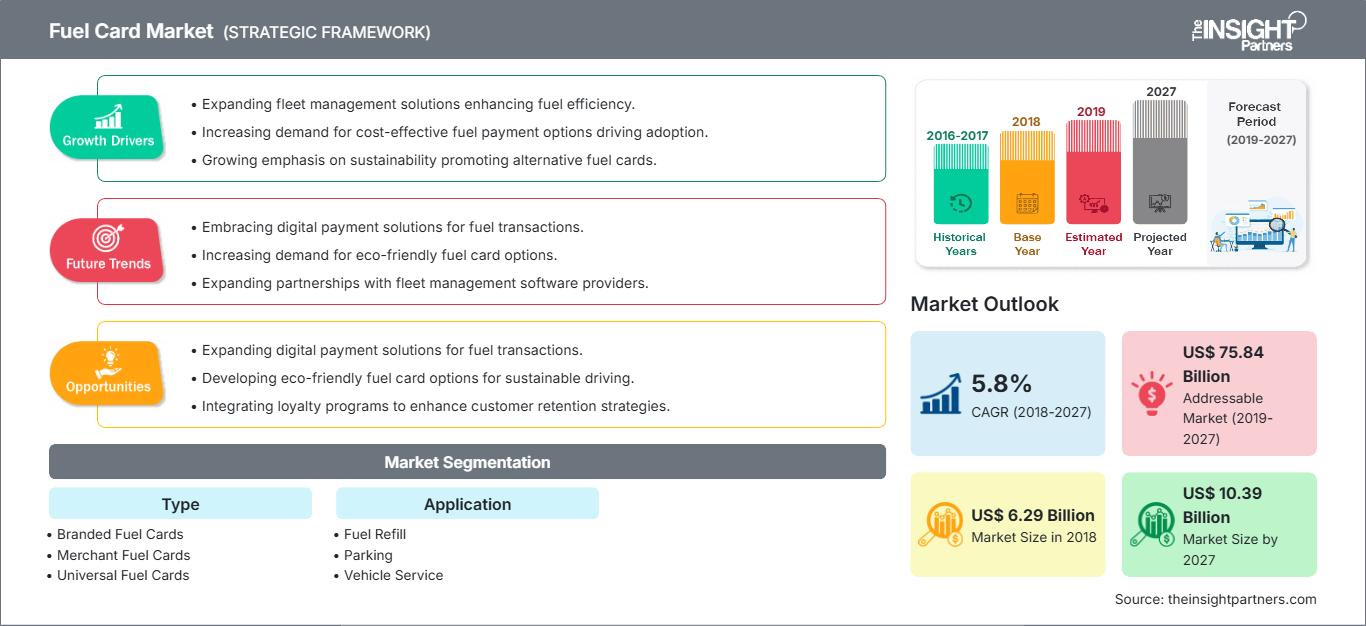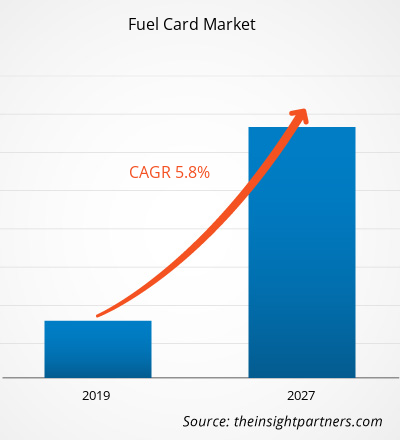[Rapporto di ricerca]Si stima che il mercato globale delle carte carburante abbia raggiunto i 6,29 miliardi di dollari nel 2018 e si prevede che crescerà a un CAGR del 5,8% nel periodo di previsione 2019-2027, raggiungendo i 10,39 miliardi di dollari entro il 2027.
La regione del Nord America detiene una quota di mercato significativa in termini di fatturato generato dalle carte carburante e si stima che continuerà a dominare la quota di mercato per tutto il periodo di previsione. Le carte universali sono il tipo di carta carburante più conveniente; i fornitori di queste carte solitamente collaborano con diverse compagnie di carburante e offrono grande flessibilità. Alcune compagnie di carte carburante operano solo in alcuni paesi o regioni, mentre altre potrebbero essere accettate solo presso determinate stazioni di servizio. Gli utenti con meno opzioni nella loro regione potrebbero dover essere cauti nel limitarle a poche stazioni di servizio.
Approfondimenti sul mercato delle carte carburante: gestione efficiente della flotta con l'ausilio di un'acquisizione dati avanzata
Le carte carburante consentono un monitoraggio più efficiente delle spese e dell'efficienza della flotta, monitorando in tempo reale il chilometraggio e il consumo di carburante dei veicoli. Gli operatori di flotte utilizzano le carte carburante per costi quali manutenzione, riparazione, carburante, pulizia e noleggio di veicoli sostitutivi, tra gli altri. I dati acquisiti da una carta carburante includono la lettura del contachilometri, la qualità del carburante, il tipo di carburante e la quantità di carburante, l'ID del veicolo, l'ID del conducente e le informazioni fiscali, insieme ai dettagli della transazione come ora, posizione, importo e data di spesa, a supporto di un'ampia riorganizzazione per i gestori di flotte. Questo fattore alimenterà la domanda del mercato delle carte carburante nel periodo di previsione.
Personalizza questo rapporto in base alle tue esigenze
Potrai personalizzare gratuitamente qualsiasi rapporto, comprese parti di questo rapporto, o analisi a livello di paese, pacchetto dati Excel, oltre a usufruire di grandi offerte e sconti per start-up e università
Mercato delle carte carburante: Approfondimenti strategici

- Ottieni le principali tendenze chiave del mercato di questo rapporto.Questo campione GRATUITO includerà l'analisi dei dati, che vanno dalle tendenze di mercato alle stime e alle previsioni.
Minore rischio di frode associato all'utilizzo delle carte carburante
Potrai personalizzare gratuitamente qualsiasi rapporto, comprese parti di questo rapporto, o analisi a livello di paese, pacchetto dati Excel, oltre a usufruire di grandi offerte e sconti per start-up e università
Mercato delle carte carburante: Approfondimenti strategici

- Ottieni le principali tendenze chiave del mercato di questo rapporto.Questo campione GRATUITO includerà l'analisi dei dati, che vanno dalle tendenze di mercato alle stime e alle previsioni.
L'utilizzo delle carte carburante offre vantaggi in termini di funzionalità e sicurezza rispetto a metodi di pagamento alternativi per il carburante, come la cassa. Le carte possono essere stampate con il numero di targa del veicolo o il nome del conducente e il nome dell'azienda, offrendo ulteriore protezione contro l'utilizzo fraudolento o le carte per il rifornimento. Informazioni complete su tutte le transazioni di carburante riducono il rischio di uso improprio da parte dei dipendenti e offrono un controllo superiore sull'utilizzo effettivo dei veicoli. Pertanto, si prevede una crescita del mercato delle carte carburante in tutto il mondo.
Approfondimenti sui segmenti di mercato
Il mercato delle carte carburante per componente è segmentato in carte carburante di marca, carte carburante per commercianti e carte carburante universali. Le carte carburante sono solitamente utilizzate da PMI e grandi aziende per monitorare i consumi e rendere più comodo effettuare pagamenti senza contanti. Tali carte sono più comuni per le aziende o le organizzazioni che si occupano di trasporti e gestione flotte. Diverse aziende che operano nel settore offrono diverse tipologie di carte. Queste carte, oltre al rifornimento di carburante, vengono utilizzate per diversi altri scopi. Le carte carburante possono essere indipendenti dalle singole categorie o essere personalizzate in base al marchio dell'emittente.
Approfondimenti sui segmenti di applicazione
Il mercato globale delle carte carburante, in base all'applicazione, è stato segmentato in rifornimento di carburante, parcheggio, assistenza veicoli, pedaggio e altri. Una carta carburante consente agli utenti e ai titolari di attività di gestire e controllare le spese di carburante e manutenzione. Sono generalmente utilizzate come carta di pagamento per i carburanti presso le stazioni di servizio. Inoltre, queste carte possono essere utilizzate anche per il pagamento di altri servizi per veicoli, come riparazioni, manutenzione e assistenza stradale. Grazie all'ampia capacità di reporting, diverse carte carburante consentono agli utenti di ottenere report in tempo reale, aiutandoli così a rimanere aggiornati su tutte le spese aziendali e a gestire le tasse sui veicoli.
Approfondimenti regionali sul mercato delle carte carburante
Le tendenze regionali e i fattori che influenzano il mercato delle carte carburante durante il periodo di previsione sono stati ampiamente spiegati dagli analisti di The Insight Partners. Questa sezione analizza anche i segmenti e la geografia del mercato delle carte carburante in Nord America, Europa, Asia-Pacifico, Medio Oriente e Africa, America meridionale e centrale.
Ambito del rapporto sul mercato delle carte carburante
| Attributo del rapporto | Dettagli |
|---|---|
| Dimensioni del mercato in 2018 | US$ 6.29 Billion |
| Dimensioni del mercato per 2027 | US$ 10.39 Billion |
| CAGR globale (2018 - 2027) | 5.8% |
| Dati storici | 2016-2017 |
| Periodo di previsione | 2019-2027 |
| Segmenti coperti |
By Tipo
|
| Regioni e paesi coperti | Nord America
|
| Leader di mercato e profili aziendali chiave |
|
Densità degli operatori del mercato delle carte carburante: comprendere il suo impatto sulle dinamiche aziendali
Il mercato delle carte carburante è in rapida crescita, trainato dalla crescente domanda degli utenti finali, dovuta a fattori quali l'evoluzione delle preferenze dei consumatori, i progressi tecnologici e una maggiore consapevolezza dei vantaggi del prodotto. Con l'aumento della domanda, le aziende stanno ampliando la propria offerta, innovando per soddisfare le esigenze dei consumatori e sfruttando le tendenze emergenti, alimentando ulteriormente la crescita del mercato.

- Ottieni il Mercato delle carte carburante Panoramica dei principali attori chiave
Alcune delle iniziative di mercato sono state considerate la strategia più adottata nel mercato globale delle carte carburante. Di seguito sono elencate alcune delle recenti iniziative di mercato:
2019: Edenred Capital Partners investe in aziende innovative con un elevato potenziale di crescita in settori correlati alle attività di Edenred. L'obiettivo è quello di migliorare l'ecosistema del Gruppo avviando preziose sinergie con le aziende supportate. 2018: Edenred, leader mondiale nelle soluzioni transazionali per aziende, dipendenti ed esercenti, ha annunciato oggi la firma di un accordo per l'acquisizione dell'80% del capitale azionario del gruppo The Right Fuelcard Company (TRFC), il quarto gestore di programmi di carte carburante nel Regno Unito.
SEGMENTAZIONE DEL MERCATO GLOBALE DELLE CARTE CARBURANTE
Mercato globale delle carte carburante - Per tipo
- Carte carburante di marca
- Carte carburante di marca del commerciante
- Carte carburante universali
Mercato globale delle carte carburante - Per applicazione
- Rifornimento carburante
- Parcheggio
- Servizio veicoli
- Pedaggio
- Altro
Mercato globale delle carte carburante - Per area geografica
Nord America
- Stati Uniti
- Canada
- Messico
Europa
- Francia
- Germania
- Italia
- Regno Unito
- Spagna
- Resto d'Europa
Asia Pacifico (APAC)
- Cina
- India
- Giappone
- Australia
- Resto dell'APAC
Medio ORIENTE e Africa (MEA)
- Arabia Saudita
- Emirati Arabi Uniti
- Sudafrica
- Resto del Medio Oriente e dell'Africa. Africa
Sud America
- Brasile
- Resto del Sud America
Mercato globale delle carte carburante - Profili aziendali
- BP PLC
- Exxon Mobil Corporation
- Fleetcor Technologies, Inc.
- Royal Dutch Shell plc
- US Bank
- Wex Inc.
- DKV
- World Fuel Services
- Edenerd
- Radius Payment Solutions.
Allstar, Arco, Caltex, Chevron Texaco, Commdel, EDC, Engen Petroleum Ltd., FastFuel, Fleetcare Pty Ltd, fuelGenie e Fuelman sono alcuni altri attori del mercato della catena del valore che non sono descritti nel rapporto, ma possono essere inclusi su richiesta.
- Analisi storica (2 anni), anno base, previsione (7 anni) con CAGR
- Analisi PEST e SWOT
- Valore/volume delle dimensioni del mercato - Globale, Regionale, Nazionale
- Industria e panorama competitivo
- Set di dati Excel
Report recenti
Testimonianze
Motivo dell'acquisto
- Processo decisionale informato
- Comprensione delle dinamiche di mercato
- Analisi competitiva
- Analisi dei clienti
- Previsioni di mercato
- Mitigazione del rischio
- Pianificazione strategica
- Giustificazione degli investimenti
- Identificazione dei mercati emergenti
- Miglioramento delle strategie di marketing
- Aumento dell'efficienza operativa
- Allineamento alle tendenze normative




















 Ottieni un campione gratuito per - Mercato delle carte carburante
Ottieni un campione gratuito per - Mercato delle carte carburante